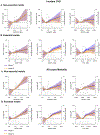Association of Urinary Metals With Cardiovascular Disease Incidence and All-Cause Mortality in the Multi-Ethnic Study of Atherosclerosis (MESA)
- PMID: 39087344
- PMCID: PMC11371385
- DOI: 10.1161/CIRCULATIONAHA.124.069414
Association of Urinary Metals With Cardiovascular Disease Incidence and All-Cause Mortality in the Multi-Ethnic Study of Atherosclerosis (MESA)
Abstract
Background: Exposure to metals has been associated with cardiovascular disease (CVD) end points and mortality, yet prospective evidence is limited beyond arsenic, cadmium, and lead. In this study, we assessed the prospective association of urinary metals with incident CVD and all-cause mortality in a racially diverse population of US adults from MESA (the Multi-Ethnic Study of Atherosclerosis).
Methods: We included 6599 participants (mean [SD] age, 62.1 [10.2] years; 53% female) with urinary metals available at baseline (2000 to 2001) and followed through December 2019. We used Cox proportional hazards models to estimate the adjusted hazard ratio and 95% CI of CVD and all-cause mortality by baseline urinary levels of cadmium, tungsten, and uranium (nonessential metals), and cobalt, copper, and zinc (essential metals). The joint association of the 6 metals as a mixture and the corresponding 10-year survival probability was calculated using Cox Elastic-Net.
Results: During follow-up, 1162 participants developed CVD, and 1844 participants died. In models adjusted by behavioral and clinical indicators, the hazard ratios (95% CI) for incident CVD and all-cause mortality comparing the highest with the lowest quartile were, respectively: 1.25 (1.03, 1.53) and 1.68 (1.43, 1.96) for cadmium; 1.20 (1.01, 1.42) and 1.16 (1.01, 1.33) for tungsten; 1.32 (1.08, 1.62) and 1.32 (1.12, 1.56) for uranium; 1.24 (1.03, 1.48) and 1.37 (1.19, 1.58) for cobalt; 1.42 (1.18, 1.70) and 1.50 (1.29, 1.74) for copper; and 1.21 (1.01, 1.45) and 1.38 (1.20, 1.59) for zinc. A positive linear dose-response was identified for cadmium and copper with both end points. The adjusted hazard ratios (95% CI) for an interquartile range (IQR) increase in the mixture of these 6 urinary metals and the corresponding 10-year survival probability difference (95% CI) were 1.29 (1.11, 1.56) and -1.1% (-2.0, -0.05) for incident CVD and 1.66 (1.47, 1.91) and -2.0% (-2.6, -1.5) for all-cause mortality.
Conclusions: This epidemiological study in US adults indicates that urinary metal levels are associated with increased CVD risk and mortality. These findings can inform the development of novel preventive strategies to improve cardiovascular health.
Keywords: cadmium; cardiovascular disease; coronary disease; metals; mortality; urine metals biomarkers.
Conflict of interest statement
None.
Figures


References
-
- McGraw KE, Schilling K, Glabonjat RA, Galvez-Fernandez M, Domingo-Relloso A, Martinez-Morata I, Jones MR, Post WS, Kaufman J, Tellez-Plaza M, Valeri L, Brown ER, Kronmal RA, Barr GR, Shea S, Navas-Acien A, Sanchez TR. Urinary metal levels and coronary artery calcification: longitudinal evidence in the Multi-Ethnic Study of Atherosclerosis (MESA). J Am Coll Cardiol. 2024; under revise and resubmit
MeSH terms
Substances
Grants and funding
- R21 HD103039/HD/NICHD NIH HHS/United States
- 75N92020D00002/HL/NHLBI NIH HHS/United States
- N01 HC095168/HL/NHLBI NIH HHS/United States
- 75N92020D00001/HL/NHLBI NIH HHS/United States
- R01 HL077612/HL/NHLBI NIH HHS/United States
- R01 ES028758/ES/NIEHS NIH HHS/United States
- N01 HC095167/HL/NHLBI NIH HHS/United States
- P42 ES033719/ES/NIEHS NIH HHS/United States
- P50 CA244693/CA/NCI NIH HHS/United States
- R21 DA024631/DA/NIDA NIH HHS/United States
- UL1 TR000040/TR/NCATS NIH HHS/United States
- N01 HC095166/HL/NHLBI NIH HHS/United States
- R01 TW007927/TW/FIC NIH HHS/United States
- N01 HC095161/HL/NHLBI NIH HHS/United States
- 75N92020D00005/HL/NHLBI NIH HHS/United States
- UL1 TR001079/TR/NCATS NIH HHS/United States
- N01 HC095169/HL/NHLBI NIH HHS/United States
- N01 HC095159/HL/NHLBI NIH HHS/United States
- 75N92020D00003/HL/NHLBI NIH HHS/United States
- UL1 TR001420/TR/NCATS NIH HHS/United States
- 75N92020D00004/HL/NHLBI NIH HHS/United States
- R01 TW009280/TW/FIC NIH HHS/United States
- T32 ES007322/ES/NIEHS NIH HHS/United States
- N01 HC095163/HL/NHLBI NIH HHS/United States
- 75N92020D00007/HL/NHLBI NIH HHS/United States
- T32 CA122061/CA/NCI NIH HHS/United States
- N01 HC095162/HL/NHLBI NIH HHS/United States
- 75N92020D00006/HL/NHLBI NIH HHS/United States
- R01 CA207158/CA/NCI NIH HHS/United States
- N01 HC095165/HL/NHLBI NIH HHS/United States
- N01 HC095164/HL/NHLBI NIH HHS/United States
- R33 HD103039/HD/NICHD NIH HHS/United States
- P30 ES009089/ES/NIEHS NIH HHS/United States
- N01 HC095160/HL/NHLBI NIH HHS/United States
LinkOut - more resources
Full Text Sources
Medical

